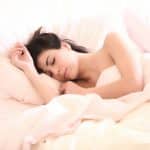Sleep is one of our basic human needs. When we consistently don’t get enough sleep, our health, both mental and physical, suffers in the long run. The cure for insomnia might be closer and simpler than you think. Try these 6 pressure points for sleep recommended by an acupressure specialist.
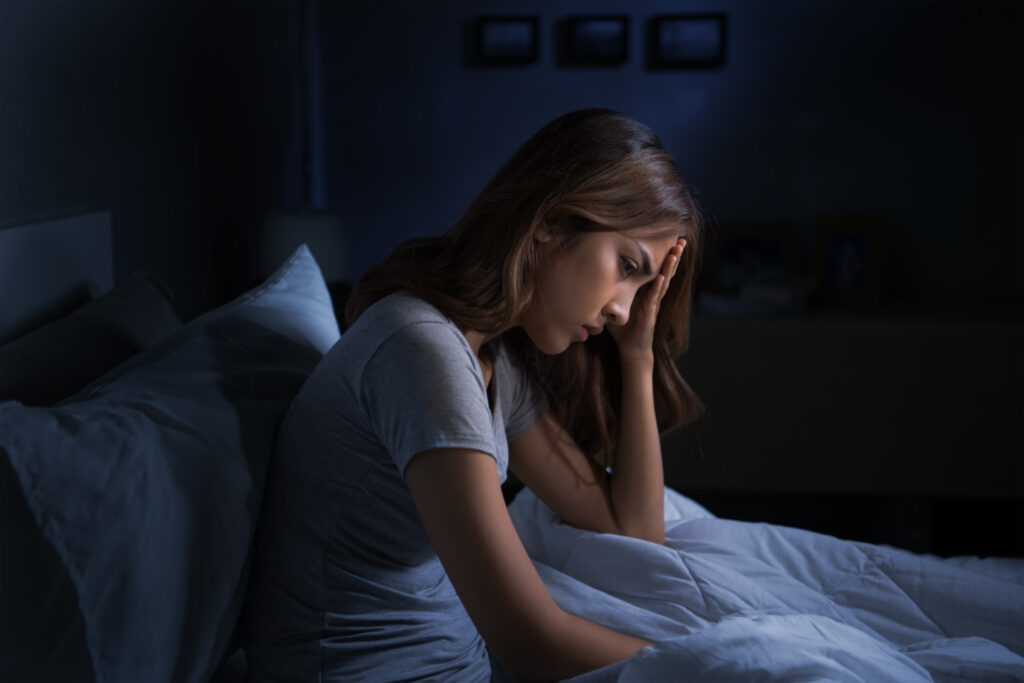
Why You Can’t Fall Asleep
Even if you prioritize sleep and try following through with discipline, set aside the time to sleep well, you still can experience insomnia. Why does it happen? The core reasons may vary stress, major life changes, anxiety, depression, pain, discomfort, illness, or a sleep disorder.
The most common sleep disorder is insomnia – difficulty falling or staying asleep. The Canadian Sleep Society estimates that up to 40% of Canadians experience at least one symptom of insomnia at some point in their lives. The symptoms can include:
- Fatigue
- Irritability
- Poor memory
- Making errors
- Difficulty focusing
- Sleepiness during the day
- Waking up too early, unable to fall back asleep
The symptoms can start small and exacerbate if the issue isn’t resolved. For some people, insomnia is short-lived, lasting a couple of days or weeks. It is resolved on its own once the underlying issue is eliminated or managed. For other people, the condition is chronic, which is classified as difficulty falling or staying asleep at least three nights a week for at least three months.
Unfortunately, the more you worry about your sleep, the more it seems to elude you. It’s like fighting a silent and frustrating battle against yourself. It becomes a major stress factor, especially when you have tried the common tips to get a good night’s rest and still can’t do so. Using pressure points for sleep is a lesser-known but extremely effective solution.
What are Pressure Points?
Acupressure works by targeting pressure points, also called acupoints. By stimulating these points, you can facilitate the healing of a specific organ, system, or process. Sleep pressure points are the specific spots on your body where you can apply pressure to treat insomnia without anyone’s help. These points can also be targeted via acupuncture with the help of an experienced specialist.
6 Types of Pressure Points for Sleep
There are 6 pressure points around the body that are effective in treating insomnia. When you massage the various pressure points to fall asleep, remember that:
- Always use firm but comfortable pressure, never painful;
- Skip acupressure if you have an injury, numbness, or a recent blood clot at the site;
- If you’re pregnant or managing a health condition, check with your doctor first.
While acupressure is a safe treatment, it is a good idea to consult a professional before undertaking any therapy. This is especially important if you are pregnant.
An Mian
The name of this pressure point for sleep aptly translates to Peaceful Dreams. The An Mian points are located on both sides of your neck – put a finger behind each earlobe and move your fingers just a bit behind the protruding bone.
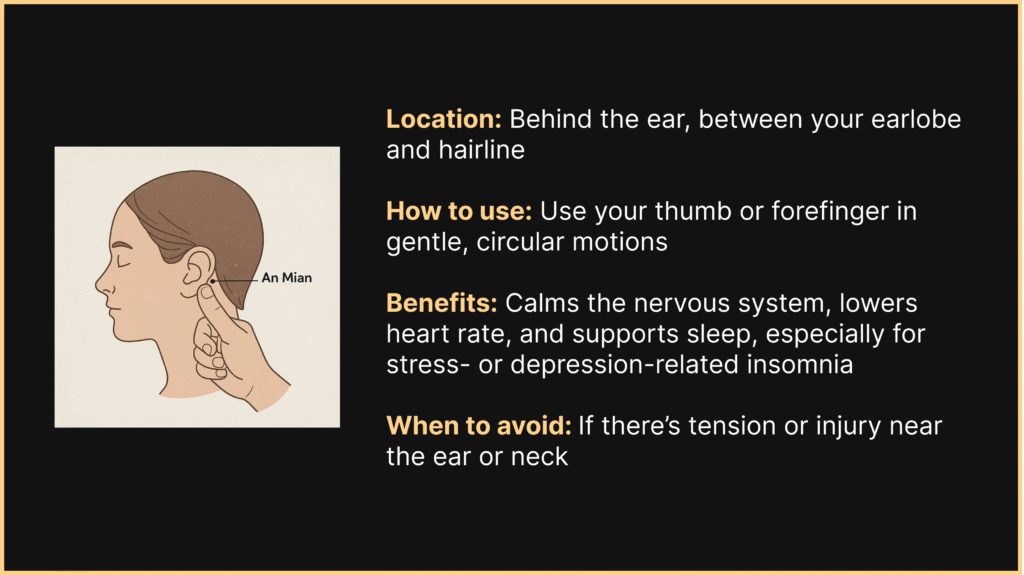
2HT7
If you are wondering what all the numbers and letters in the name are for, it’s because they signify a specific organ and pressure point. If your mind won’t shut off at night, HT7, also known as Shen Men or Spirit Gate, might help bring it back to calm. This wrist point is often used to ease emotional restlessness.

SP6
SP6 (San Yin Jiao or Three Yin Intersection) is a go-to for full-body relaxation. This point is often used in acupressure and acupuncture for everything from sleep to hormonal balance.

LV3
Feeling tension in your mind or body? That might be what’s keeping you from having a peaceful sleep. LV3 (Tai Chong or Great Surge) will help dial down that racing energy and ease stress that can keep you up at night.

KD3
This ankle point has a grounding effect. KD3, also called Taixi or Great Ravine, is often used in routines for people dealing with long-term sleep trouble or tension from hypertension.
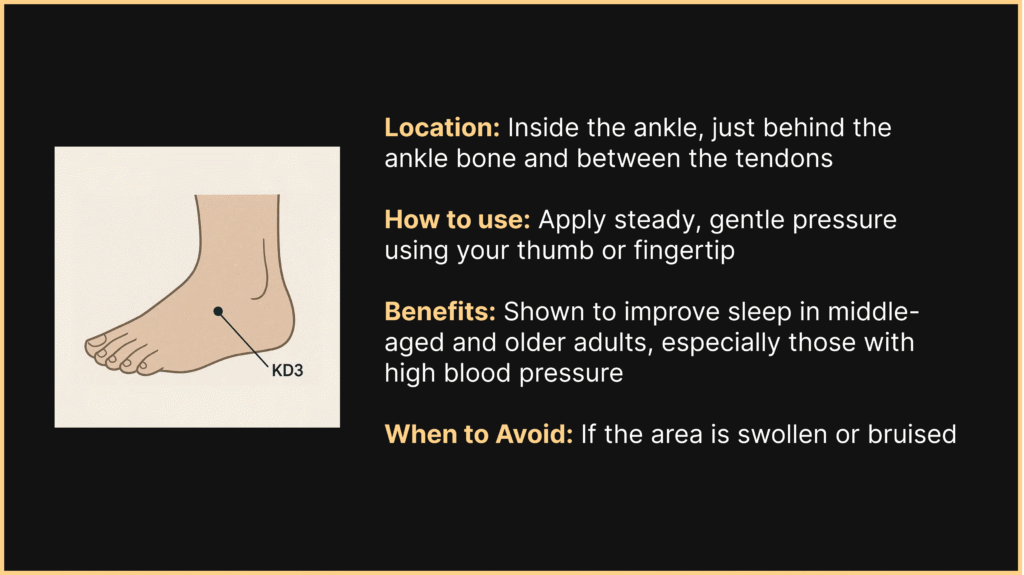
Yin Tang
If you need to clear your head before bed, Yin Tang, often referred to as the Third Eye or Hall of Impression, is that classic “third eye” spot you might have heard about. It’s used to quiet the mind and calm the body.
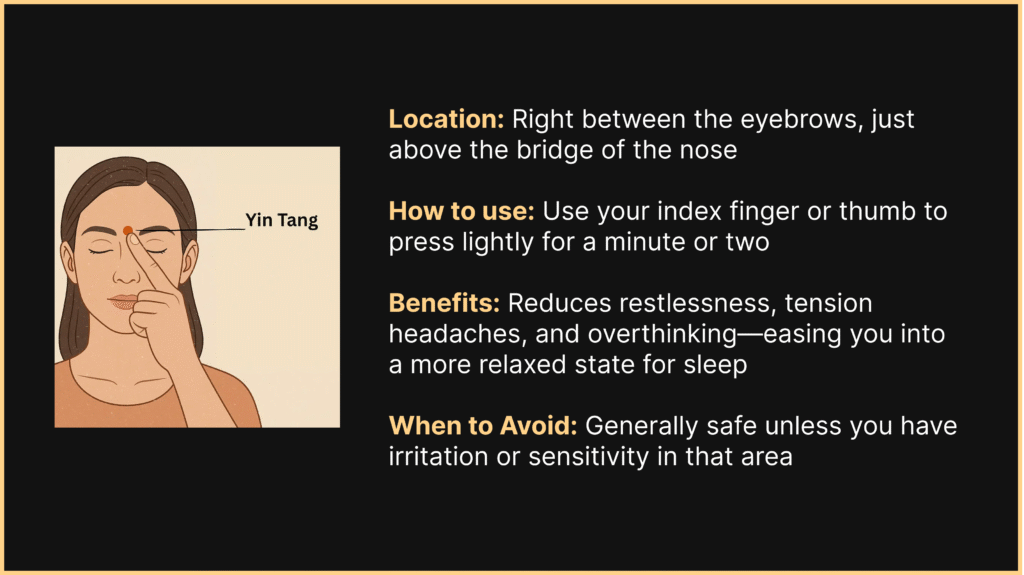
How to Use Sleep Pressure Points
This can be performed on your own with your finger, thumb, or knuckle. You can even opt for a blunt object or massage tool. You can also ask someone to help you massage the pressure points for you. Another option is to go to an acupressure practitioner or massage therapist.
You can also experiment with acupressure at different times leading up to bedtime. Some people prefer doing acupressure in bed, while others like it more when it’s done an hour before bedtime. Some of the pressure points, such as those around the head and wrists, can be massaged while you are in bed. Others, like those around the ankles and feet, could be massaged as part of your routine as you wind down.
Try out different variations to find what suits you best. Ultimately, add acupressure to your routine along with other relaxing habits, such as stretching, deep breathing, and limiting screen time, coffee, and alcohol before bed.
Consult with Professionals for Sleep Pressure Points
Being sleep-deprived is difficult and affects every area of your life. It shouldn’t be a condition you have to live with. You deserve adequate rest, not just to function well from day to day, but also as a self-nurturing investment in your health, both now and in the future.
Start enjoying a good night’s sleep again with the help of Newmarket Health & Wellness Centre. Our experienced specialists use acupressure and acupuncture to help you get your good sleep back. You can be sure that we target accurate sleep pressure points, putting the right amount of pressure. We will assist you with any questions and concerns and offer a personalized plan that will help you with insomnia symptoms.
To get more information or to book an acupressure appointment at one of our centres, feel free to contact us. We’re happy to help you get better sleep.
Conclusion
Acupressure is a technique that has helped many people struggling with insomnia. You can safely use pressure points for sleep issues and get better sleep as long as you follow the guidelines. Just these 6 points are a great start and make a difference if you make them part of your routine.
Pressure Points for Sleep FAQ
-
What is a Chinese technique for falling asleep?
A traditional Chinese technique for falling asleep is acupressure. You stimulate specific acupoints (acupuncture points) on your body to promote relaxation and calm the mind. You can do it on your own, go to a specialist, or combine it with another therapy method, such as acupuncture. -
Can pressure points improve sleep?
Extensive scientific research is yet to be done to provide robust evidence for each pressure point and for acupressure in general. However, several studies, along with anecdotal evidence, suggest that pressure points are effective in treating insomnia. The points correspond to different aspects of falling asleep, such as relaxing the mind, slowing the heart rate, and relieving muscle tension. -
Is acupressure effective for insomnia?
Yes, there are many benefits to acupressure, similar to those of acupuncture. Some findings suggest that acupressure is beneficial in treating insomnia that comes as a consequence of cancer treatment, menopause, anxiety, depression, Alzheimer’s disease, and hypertension without worrying about side effects or drug interactions.

